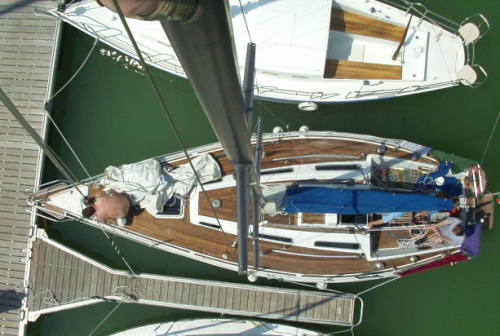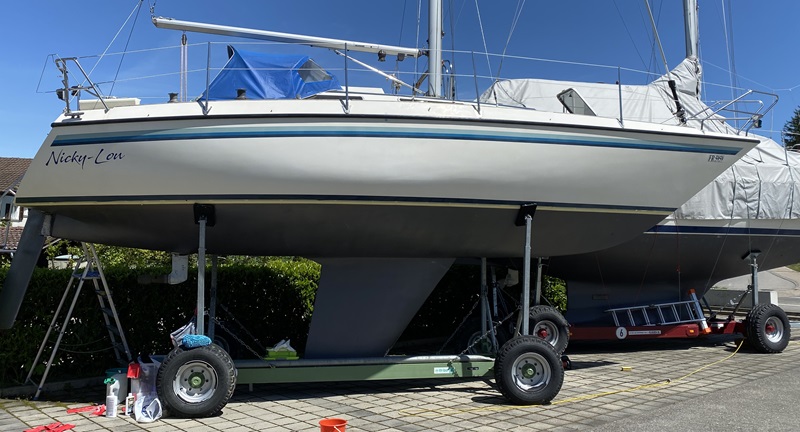Review of Granada 31


Basic specs.

Looking for a new boat? Find a Granada 31 or similar boat for sale
Both the hull and the deck is made of fibreglass. Generally, a hull made of fibreglass requires only a minimum of maintenance during the sailing season. And outside the sailing season, just bottom cleaning and perhaps anti-fouling painting once a year - a few hours of work, that's all.
The hull is a sandwich construction which improves the indoor climate. Especially when the water is colder than the air in the cabin, then the double hull insulates against cold water and reduce the condense water in the cabin. The core material in the sandwich construction is balsa.
The interior is like most other boats made of teak. Teak has the advantage of being naturally very oily and therefore water-repellent, which is suitable on boats.
The boat is equipped with 6 berths, a galley, 100.0 liter fresh water capacity and toilet facility.
Note: the boat has also been sold to be self-made/-interiored, which means that the quality of each boat may vary.
The Granada 31 is built with a masthead rig. The advantage of a masthead rig is its simplicity and the fact that a given sail area - compared with a fractional rig - can be carried lower and thus with less heeling moment.

Fin keel
The Granada 31 is built with a fin keel. A boat with a fin keel is more manoeuvrable but has less directional stability than a similar boat with a full keel.
The keel is made of iron. Many people prefer lead keel in favour of iron. The main argument is that lead is much heavier than iron and a lead keel can therefore be made smaller which again result in less wet surface, i.e. less drag. In fact iron is quite heavy, just 30% less heavy than lead, so the advantage of a lead keel is often overstated. As the surface of a fin type keel is just a fraction of the total wet surface, the difference between an iron keel and a lead keel can in reality be ignored for cruising yachts.
Granada 31 can enter most marinas as the draft is just about 1.75 - 1.85 meter (5.74 - 6.04 ft) dependent on the load. See immersion rate below.
The boat may be equipped with an inboard Volvo Penta MD7 diesel engine at 13 hp (9 kW). Calculated max speed is about 4.7 knots
The transmission is a saildrive.
The fuel tank, which is made of stainless steel, has a capacity of 50.0 liters (13 US gallons, 10 imperial gallons).
Sailing characteristics
This section covers widely used rules of thumb to describe the sailing characteristics. Please note that even though the calculations are correct, the interpretation of the results might not be valid for extreme boats.
What is Capsize Screening Formula (CSF)?
The capsize screening value for Granada 31 is 2.01, indicating that this boat would not be accepted to participate in ocean races.
What is Theoretical Maximum Hull Speed?
The theoretical maximal speed of a displacement boat of this length is 6.6 knots. The term "Theoretical Maximum Hull Speed" is widely used even though a boat can sail faster. The term shall be interpreted as above the theoretical speed a great additional power is necessary for a small gain in speed.
The immersion rate is defined as the weight required to sink the boat a certain level.
The immersion rate for Granada 31 is about 151 kg/cm, alternatively 845 lbs/inch.
Meaning: if you load 151 kg cargo on the boat then it will sink 1 cm.
Alternatively, if you load 845 lbs cargo on the boat it will sink 1 inch.
Sailing statistics
This section is statistical comparison with similar boats of the same category. The basis of the following statistical computations is our unique database with more than 26,000 different boat types and 350,000 data points.
What is Motion Comfort Ratio (MCR)?
The Motion Comfort Ratio for Granada 31 is 21.6.
What is L/B (Length Beam Ratio)?
The l/b ratio for Granada 31 is 3.08.
The ballast ratio for Granada 31 is 40%.
What is Displacement Length Ratio?
The DL-ratio for Granada 31 is 248 which categorizes this boat among 'light crusers & offshore racers'.
What is SA/D (Sail Area Displacement ratio)?
The SA/D for Granada 31 with ISO 8666 reference sail is 16.9, with a 135% genua the SA/D is 20.0.
What is Relative Speed Performance?
The Relative Speed Performance for Granada 31 is 62
Maintenance
As balsa wood is used as sandwich core material special care must be taken in relation to work that require penetration of the sandwich construction in order to to prevent water to get in contact with the balsa wood. Otherwise the balsa wood will eventually rotten and be expensive/impossible to repair.
When buying anti-fouling bottom paint, it's nice to know how much to buy.
The surface of the wet bottom is about 27m2 (290 ft2).
Based on this, your favourite maritime shop can tell you the quantity you need.
Note: If you use a paint roller you will need more paint than if you use a paintbrush.
Dimensions of sail for masthead rig.



Are your sails worn out? You might find your next sail here: Sails for Sale
If you need to renew parts of your running rig and is not quite sure of the dimensions, you may find the estimates computed below useful.
| Usage | Length | Diameter | ||
| Mainsail halyard | 29.6 m | (96.9 feet) | 10 mm | (3/8 inch) |
| Jib/genoa halyard | 29.6 m | (96.9 feet) | 10 mm | (3/8 inch) |
| Spinnaker halyard | 29.6 m | (96.9 feet) | 10 mm | (3/8 inch) |
| Jib sheet | 9.4 m | (30.8 feet) | 12 mm | (1/2 inch) |
| Genoa sheet | 9.4 m | (30.8 feet) | 12 mm | (1/2 inch) |
| Mainsheet | 23.5 m | (76.9 feet) | 12 mm | (1/2 inch) |
| Spinnaker sheet | 20.6 m | (67.7 feet) | 12 mm | (1/2 inch) |
| Cunningham | 3.2 m | (10.7 feet) | 10 mm | (3/8 inch) |
| Kickingstrap | 6.5 m | (21.3 feet) | 10 mm | (3/8 inch) |
| Clew-outhaul | 6.5 m | (21.3 feet) | 10 mm | (3/8 inch) |
This section is reserved boat owner's modifications, improvements, etc. Here you might find (or contribute with) inspiration for your boat.
Do you have changes/improvements you would like to share? Upload a photo and describe what you have done.
We are always looking for new photos. If you can contribute with photos for Granada 31 it would be a great help.
If you have any comments to the review, improvement suggestions, or the like, feel free to contact us. Criticism helps us to improve.
